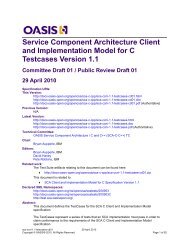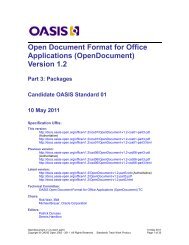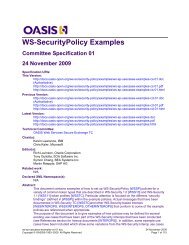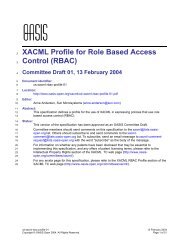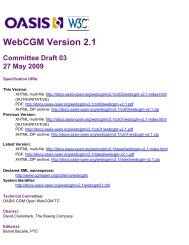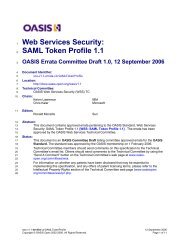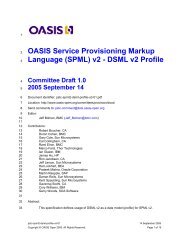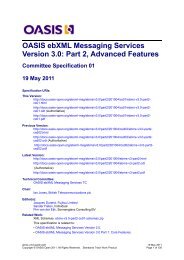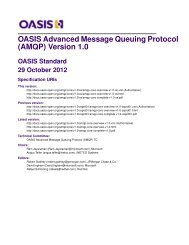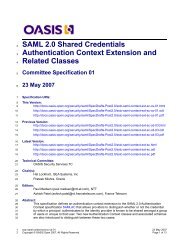Web Services Atomic Transaction 1.1 - OASIS Open Library
Web Services Atomic Transaction 1.1 - OASIS Open Library
Web Services Atomic Transaction 1.1 - OASIS Open Library
Create successful ePaper yourself
Turn your PDF publications into a flip-book with our unique Google optimized e-Paper software.
<strong>Web</strong> <strong>Services</strong> <strong>Atomic</strong> <strong>Transaction</strong> (WS-<br />
<strong>Atomic</strong><strong>Transaction</strong>) <strong>1.1</strong><br />
Committee Draft 01, March 15, 2006<br />
Document Identifier:<br />
wstx-wsat-<strong>1.1</strong>-spec-cd-01<br />
Location:<br />
http://docs.oasis-open.org/ws-tx/wstx-wsat-<strong>1.1</strong>-spec-cd-01.pdf<br />
Technical Committee:<br />
<strong>OASIS</strong> WS-TX TC<br />
Chair(s):<br />
Eric Newcomer, Iona<br />
Ian Robinson, IBM<br />
Editor(s):<br />
Mark Little, JBoss Inc. <br />
Andrew Wilkinson, IBM <br />
Abstract:<br />
This specification provides the definition of the atomic transaction coordination type that is to be<br />
used with the extensible coordination framework described in the WS-Coordination specification.<br />
The specification defines three specific agreement coordination protocols for the atomic<br />
transaction coordination type: completion, volatile two-phase commit, and durable two-phase<br />
commit. Developers can use any or all of these protocols when building applications that require<br />
consistent agreement on the outcome of short-lived distributed activities that have the all-ornothing<br />
property.<br />
Status:<br />
This document is published by the WS-TX TC as a “committee draft".<br />
This document was last revised or approved by the WS-TX TC on the above date. The level of<br />
approval is also listed above. Check the current location noted above for possible later revisions<br />
of this document. This document is updated periodically on no particular schedule.<br />
Technical Committee members should send comments on this specification to the Technical<br />
Committee’s email list. Others should send comments to the Technical Committee by using the<br />
“Send A Comment” button on the Technical Committee’s web page at www.oasisopen.org/committees/ws-tx<br />
.<br />
For information on whether any patents have been disclosed that may be essential to<br />
implementing this specification, and any offers of patent licensing terms, please refer to the<br />
Intellectual Property Rights section of the Technical Committee web page (www.oasisopen.org/committees/ws-tx/ipr.php<br />
).<br />
The non-normative errata page for this specification is located at www.oasisopen.org/committees/ws-tx<br />
.<br />
wstx-wsat-<strong>1.1</strong>-spec-cd-01 March 15, 2006<br />
Copyright © <strong>OASIS</strong> <strong>Open</strong> 2006. All Rights Reserved. Page 1 of 27
Notices<br />
<strong>OASIS</strong> takes no position regarding the validity or scope of any intellectual property or other rights that<br />
might be claimed to pertain to the implementation or use of the technology described in this document or<br />
the extent to which any license under such rights might or might not be available; neither does it<br />
represent that it has made any effort to identify any such rights. Information on <strong>OASIS</strong>'s procedures with<br />
respect to rights in <strong>OASIS</strong> specifications can be found at the <strong>OASIS</strong> website. Copies of claims of rights<br />
made available for publication and any assurances of licenses to be made available, or the result of an<br />
attempt made to obtain a general license or permission for the use of such proprietary rights by<br />
implementers or users of this specification, can be obtained from the <strong>OASIS</strong> President.<br />
<strong>OASIS</strong> invites any interested party to bring to its attention any copyrights, patents or patent applications,<br />
or other proprietary rights which may cover technology that may be required to implement this<br />
specification. Please address the information to the <strong>OASIS</strong> President.<br />
Copyright © <strong>OASIS</strong> <strong>Open</strong> 2006. All Rights Reserved.<br />
This document and translations of it may be copied and furnished to others, and derivative works that<br />
comment on or otherwise explain it or assist in its implementation may be prepared, copied, published<br />
and distributed, in whole or in part, without restriction of any kind, provided that the above copyright notice<br />
and this paragraph are included on all such copies and derivative works. However, this document itself<br />
does not be modified in any way, such as by removing the copyright notice or references to <strong>OASIS</strong>,<br />
except as needed for the purpose of developing <strong>OASIS</strong> specifications, in which case the procedures for<br />
copyrights defined in the <strong>OASIS</strong> Intellectual Property Rights document must be followed, or as required to<br />
translate it into languages other than English.<br />
The limited permissions granted above are perpetual and will not be revoked by <strong>OASIS</strong> or its successors<br />
or assigns.<br />
This document and the information contained herein is provided on an “AS IS” basis and <strong>OASIS</strong><br />
DISCLAIMS ALL WARRANTIES, EXPRESS OR IMPLIED, INCLUDING BUT NOT LIMITED TO ANY<br />
WARRANTY THAT THE USE OF THE INFORMATION HEREIN WILL NOT INFRINGE ANY RIGHTS OR<br />
ANY IMPLIED WARRANTIES OF MERCHANTABILITY OR FITNESS FOR A PARTICULAR PURPOSE.<br />
wstx-wsat-<strong>1.1</strong>-spec-cd-01 March 15, 2006<br />
Copyright © <strong>OASIS</strong> <strong>Open</strong> 2006. All Rights Reserved. Page 2 of 27
Table of contents<br />
1 Note on terminology............................................................................................................................. 4<br />
<strong>1.1</strong> Composable Architecture................................................................................................................... 4<br />
1.2 Namespace ........................................................................................................................................ 4<br />
1.2.1 Prefix Namespace ...................................................................................................................... 4<br />
1.3 XSD and WSDL Files......................................................................................................................... 4<br />
1.4 AT Protocol Elements ........................................................................................................................ 5<br />
1.5 Normative References ....................................................................................................................... 5<br />
1.6 Non-normative References ................................................................................................................ 5<br />
2 Introduction .......................................................................................................................................... 7<br />
3 <strong>Atomic</strong> <strong>Transaction</strong> Context................................................................................................................. 8<br />
4 <strong>Atomic</strong> <strong>Transaction</strong> Protocols .............................................................................................................. 9<br />
4.1 Preconditions ..................................................................................................................................... 9<br />
4.2 Completion Protocol........................................................................................................................... 9<br />
4.3 Two-Phase Commit Protocol ........................................................................................................... 10<br />
4.3.1 Volatile Two-Phase Commit Protocol ....................................................................................... 10<br />
4.3.2 Durable Two-Phase Commit Protocol ...................................................................................... 11<br />
4.3.3 2PC Diagram and Notifications................................................................................................. 11<br />
5 AT Policy Assertion............................................................................................................................ 13<br />
5.1 Assertion Model ............................................................................................................................... 13<br />
5.2 Normative Outline ............................................................................................................................ 13<br />
5.3 Assertion Attachment....................................................................................................................... 14<br />
5.4 Assertion Example ........................................................................................................................... 14<br />
6 <strong>Transaction</strong> Faults ............................................................................................................................. 16<br />
6.1 InconsistentInternalState.................................................................................................................. 17<br />
7 Security Model ................................................................................................................................... 18<br />
8 Security Considerations..................................................................................................................... 20<br />
9 Use of WS-Addressing Headers........................................................................................................ 22<br />
10 State Tables....................................................................................................................................... 23<br />
Appendix A. Acknowledgements................................................................................................................ 26<br />
Appendix B. Revision History ..................................................................................................................... 27<br />
wstx-wsat-<strong>1.1</strong>-spec-cd-01 March 15, 2006<br />
Copyright © <strong>OASIS</strong> <strong>Open</strong> 2006. All Rights Reserved. Page 3 of 27
1<br />
2<br />
3<br />
4<br />
5<br />
6<br />
7<br />
8<br />
9<br />
10<br />
11<br />
12<br />
13<br />
14<br />
15<br />
16<br />
17<br />
18<br />
1 Note on terminology<br />
The keywords "MUST", "MUST NOT", "REQUIRED", "SHALL", "SHALL NOT", "SHOULD", "SHOULD<br />
NOT", "RECOMMENDED", "MAY", and "OPTIONAL" in this document are to be interpreted as described<br />
in RFC2119 [KEYWORDS].<br />
Namespace URIs of the general form http://example.org and http://example.com represents some<br />
application-dependent or context-dependent URI as defined in RFC 2396 [URI].<br />
<strong>1.1</strong> Composable Architecture<br />
By using the SOAP [SOAP]and WSDL [WSDL] extensibility model, SOAP-based and WSDL-based<br />
specifications are designed to work together to define a rich <strong>Web</strong> services environment. As such, WS-<br />
<strong>Atomic</strong><strong>Transaction</strong> by itself does not define all features required for a complete solution. WS-<br />
<strong>Atomic</strong><strong>Transaction</strong> is a building block used with other specifications of <strong>Web</strong> services (e.g., WS-<br />
Coordination, WS-Security) and application-specific protocols that are able to accommodate a wide<br />
variety of coordination protocols related to the coordination actions of distributed applications.<br />
1.2 Namespace<br />
The XML namespace URI that MUST be used by implementations of this specification is:<br />
http://docs.oasis-open.org/ws-tx/wsat/2006/03<br />
This is also used as the CoordinationContext type for atomic transactions.<br />
1.2.1 Prefix Namespace<br />
Prefix<br />
S<br />
wscoor<br />
wsat<br />
Namespace<br />
http://www.w3.org/2003/05/soap-envelope<br />
http://docs.oasis-open.org/ws-tx/wscoor/2006/03<br />
http://docs.oasis-open.org/ws-tx/wsat/2006/03<br />
19<br />
20<br />
21<br />
22<br />
23<br />
24<br />
25<br />
26<br />
27<br />
If an action URI is used then the action URI MUST consist of the wsat namespace URI concatenated with<br />
the "/" character and the element name. For example:<br />
http://docs.oasis-open.org/ws-tx/wsat/2006/03/Commit<br />
1.3 XSD and WSDL Files<br />
The following links hold the XML schema and the WSDL declarations defined in this document.<br />
http://docs.oasis-open.org/ws-tx/wsat/2006/03/wsat.xsd<br />
http://docs.oasis-open.org/ws-tx/wsat/2006/03/wsat.wsdl<br />
Soap bindings for the WSDL documents defined in this specification MUST use "document" for the style<br />
attribute.<br />
wstx-wsat-<strong>1.1</strong>-spec-cd-01 March 15, 2006<br />
Copyright © <strong>OASIS</strong> <strong>Open</strong> 2006. All Rights Reserved. Page 4 of 27
28<br />
29<br />
30<br />
31<br />
32<br />
33<br />
34<br />
35<br />
36<br />
37<br />
38<br />
39<br />
40<br />
41<br />
42<br />
43<br />
44<br />
45<br />
46<br />
47<br />
48<br />
49<br />
50<br />
51<br />
52<br />
53<br />
54<br />
55<br />
56<br />
57<br />
58<br />
59<br />
60<br />
61<br />
62<br />
1.4 AT Protocol Elements<br />
The protocol elements define various extensibility points that allow other child or attribute content.<br />
Additional children and/or attributes MAY be added at the indicated extension points but MUST NOT<br />
contradict the semantics of the parent and/or owner, respectively. If a receiver does not recognize an<br />
extension, the receiver SHOULD ignore the extension.<br />
1.5 Normative References<br />
1.6 Non-normative References<br />
[KEYWORDS]<br />
S. Bradner, "Key words for use in RFCs to Indicate Requirement Levels," RFC 2119, Harvard<br />
University, March 1997<br />
[SOAP]<br />
W3C Note, "SOAP: Simple Object Access Protocol <strong>1.1</strong>," 08 May 2000<br />
[URI]<br />
T. Berners-Lee, R. Fielding, L. Masinter, "Uniform Resource Identifiers (URI): Generic Syntax,"<br />
RFC 2396, MIT/LCS, U.C. Irvine, Xerox Corporation, August 1998<br />
[XML-ns]<br />
W3C Recommendation, "Namespaces in XML," 14 January 1999<br />
[XML-Schema1]<br />
W3C Recommendation, "XML Schema Part 1: Structures," 2 May 2001<br />
[XML-Schema2]<br />
W3C Recommendation, "XML Schema Part 2: Datatypes," 2 May 2001<br />
[WSCOOR]<br />
<strong>Web</strong> <strong>Services</strong> Coordination (WS-Coordination) <strong>1.1</strong>, <strong>OASIS</strong>, March 2006<br />
[WSADDR]<br />
<strong>Web</strong> <strong>Services</strong> Addressing (WS-Addressing), Microsoft, IBM, Sun, BEA Systems, SAP, Sun,<br />
August 2004<br />
[WSPOLICY]<br />
<strong>Web</strong> <strong>Services</strong> Policy Framework (WS-Policy), VeriSign, Microsoft, Sonic Software, IBM, BEA<br />
Systems, SAP, September 2004<br />
[WSPOLICYATTACH]<br />
<strong>Web</strong> <strong>Services</strong> Policy Attachment (WS-PolicyAttachment), VeriSign, Microsoft, Sonic Software,<br />
IBM, BEA Systems, SAP, September 2004<br />
[WSDL]<br />
<strong>Web</strong> <strong>Services</strong> Description Language (WSDL) <strong>1.1</strong><br />
"http://www.w3.org/TR/2001/NOTE-wsdl-20010315"<br />
wstx-wsat-<strong>1.1</strong>-spec-cd-01 March 15, 2006<br />
Copyright © <strong>OASIS</strong> <strong>Open</strong> 2006. All Rights Reserved. Page 5 of 27
63<br />
64<br />
65<br />
66<br />
67<br />
68<br />
69<br />
70<br />
71<br />
72<br />
73<br />
74<br />
75<br />
76<br />
[WSSec]<br />
<strong>OASIS</strong> Standard 200401, March 2004, "<strong>Web</strong> <strong>Services</strong> Security: SOAP Message Security 1.0<br />
(WS-Security 2004)"<br />
[WSSecPolicy]<br />
<strong>Web</strong> <strong>Services</strong> Security Policy Language (WS-SecurityPolicy), Microsoft, VeriSign, IBM, RSA<br />
Security, July 2005<br />
[WSSecConv]<br />
<strong>Web</strong> <strong>Services</strong> Secure Conversation Language (WS-SecureConversation), <strong>Open</strong>Network, Layer7,<br />
Netegrity, Microsoft, Reactivity, IBM, VeriSign, BEA Systems, Oblix, RSA Security, Ping Identity,<br />
Westbridge, Computer Associates, February 2005<br />
[WSTrust]<br />
<strong>Web</strong> <strong>Services</strong> Trust Language (WS-Trust), <strong>Open</strong>Network, Layer7, Netegrity, Microsoft,<br />
Reactivity, VeriSign, IBM, BEA Systems, Oblix, RSA Security, Ping Identity, Westbridge,<br />
Computer Associates, February 2005.<br />
wstx-wsat-<strong>1.1</strong>-spec-cd-01 March 15, 2006<br />
Copyright © <strong>OASIS</strong> <strong>Open</strong> 2006. All Rights Reserved. Page 6 of 27
77<br />
78<br />
79<br />
80<br />
81<br />
82<br />
83<br />
84<br />
85<br />
86<br />
87<br />
88<br />
89<br />
90<br />
91<br />
92<br />
93<br />
94<br />
95<br />
96<br />
97<br />
98<br />
99<br />
100<br />
101<br />
102<br />
103<br />
104<br />
105<br />
106<br />
107<br />
2 Introduction<br />
The current set of <strong>Web</strong> service specifications [WSDL] [SOAP] defines protocols for <strong>Web</strong> service<br />
interoperability. <strong>Web</strong> services increasingly tie together a number of participants forming large distributed<br />
applications. The resulting activities may have complex structure and relationships.<br />
The WS-Coordination specification defines an extensible framework for defining coordination types. This<br />
specification provides the definition of an atomic transaction coordination type used to coordinate<br />
activities having an "all or nothing" property. <strong>Atomic</strong> transactions commonly require a high level of trust<br />
between participants and are short in duration. The <strong>Atomic</strong> <strong>Transaction</strong> specification defines protocols<br />
that enable existing transaction processing systems to wrap their proprietary protocols and interoperate<br />
across different hardware and software vendors.<br />
To understand the protocol described in this specification, the following assumptions are made:<br />
• The reader is familiar with existing standards for two-phase commit protocols and with<br />
commercially available implementations of such protocols. Therefore this section includes only<br />
those details that are essential to understanding the protocols described.<br />
• The reader is familiar with the WS-Coordination [WSCOOR] specification that defines the<br />
framework for the WS-<strong>Atomic</strong><strong>Transaction</strong> coordination protocols.<br />
• The reader is familiar with WS-Addressing [WSADDR] and WS-Policy [WSPOLICY].<br />
<strong>Atomic</strong> transactions have an all-or-nothing property. The actions taken prior to commit are only tentative<br />
(i.e., not persistent and not visible to other activities). When an application finishes, it requests the<br />
coordinator to determine the outcome for the transaction. The coordinator determines if there were any<br />
processing failures by asking the participants to vote. If the participants all vote that they were able to<br />
execute successfully, the coordinator commits all actions taken. If a participant votes that it needs to<br />
abort or a participant does not respond at all, the coordinator aborts all actions taken. Commit makes the<br />
tentative actions visible to other transactions. Abort makes the tentative actions appear as if the actions<br />
never happened. <strong>Atomic</strong> transactions have proven to be extremely valuable for many applications. They<br />
provide consistent failure and recovery semantics, so the applications no longer need to deal with the<br />
mechanics of determining a mutually agreed outcome decision or to figure out how to recover from a<br />
large number of possible inconsistent states.<br />
<strong>Atomic</strong> <strong>Transaction</strong> defines protocols that govern the outcome of atomic transactions. It is expected that<br />
existing transaction processing systems wrap their proprietary mechanisms and interoperate across<br />
different vendor implementations.<br />
wstx-wsat-<strong>1.1</strong>-spec-cd-01 March 15, 2006<br />
Copyright © <strong>OASIS</strong> <strong>Open</strong> 2006. All Rights Reserved. Page 7 of 27
108<br />
109<br />
110<br />
111<br />
112<br />
113<br />
114<br />
115<br />
116<br />
117<br />
118<br />
119<br />
120<br />
121<br />
122<br />
123<br />
124<br />
125<br />
3 <strong>Atomic</strong> <strong>Transaction</strong> Context<br />
<strong>Atomic</strong> <strong>Transaction</strong> builds on WS-Coordination, which defines an activation and a registration service.<br />
Example message flows and a complete description of creating and registering for coordinated activities<br />
is found in the WS-Coordination specification [WSCOOR].<br />
The <strong>Atomic</strong> <strong>Transaction</strong> coordination context must flow on all application messages involved with the<br />
transaction.<br />
<strong>Atomic</strong> <strong>Transaction</strong> adds the following semantics to the CreateCoordinationContext operation on the<br />
activation service.<br />
• If the request includes the CurrentContext element, the target coordinator is interposed as a<br />
subordinate to the coordinator stipulated inside the CurrentContext element.<br />
• If the request does not include a CurrentContext element, the target coordinator creates a new<br />
transaction and acts as the root.<br />
A coordination context may have an Expires attribute. This attribute specifies the earliest point in time at<br />
which a transaction may be terminated solely due to its length of operation. From that point forward, the<br />
transaction manager may elect to unilaterally roll back the transaction, so long as it has not transmitted a<br />
Commit or a Prepared notification.<br />
The <strong>Atomic</strong> <strong>Transaction</strong> protocol is identified by the following coordination type:<br />
http://docs.oasis-open.org/ws-tx/wsat/2006/03<br />
wstx-wsat-<strong>1.1</strong>-spec-cd-01 March 15, 2006<br />
Copyright © <strong>OASIS</strong> <strong>Open</strong> 2006. All Rights Reserved. Page 8 of 27
126<br />
127<br />
128<br />
129<br />
130<br />
131<br />
132<br />
133<br />
4 <strong>Atomic</strong> <strong>Transaction</strong> Protocols<br />
This specification defines the following protocols for atomic transactions.<br />
• Completion: The completion protocol initiates commitment processing. Based on each<br />
protocol's registered participants, the coordinator begins with Volatile 2PC then proceeds through<br />
Durable 2PC. The final result is signaled to the initiator.<br />
• Two-Phase Commit (2PC): The 2PC protocol coordinates registered participants to reach a<br />
commit or abort decision, and ensures that all participants are informed of the final result. The<br />
2PC protocol has two variants:<br />
134<br />
135<br />
136<br />
137<br />
o<br />
o<br />
Volatile 2PC: Participants managing volatile resources such as a cache should<br />
register for this protocol.<br />
Durable 2PC: Participants managing durable resources such as a database should<br />
register for this protocol.<br />
138<br />
139<br />
140<br />
141<br />
142<br />
143<br />
144<br />
145<br />
146<br />
147<br />
148<br />
149<br />
150<br />
A participant can register for more than one of these protocols by sending multiple Register messages.<br />
4.1 Preconditions<br />
The correct operation of the protocols requires that a number of preconditions MUST be established prior<br />
to the processing:<br />
1. The source MUST have knowledge of the destination's policies, if any, and the source MUST be<br />
capable of formulating messages that adhere to this policy.<br />
2. If a secure exchange of messages is required, then the source and destination MUST have a<br />
security context.<br />
4.2 Completion Protocol<br />
The Completion protocol is used by an application to tell the coordinator to either try to commit or abort an<br />
atomic transaction. After the transaction has completed, a status is returned to the application.<br />
An initiator registers for this protocol using the following protocol identifier:<br />
http://docs.oasis-open.org/ws-tx/wsat/2006/03/Completion<br />
151<br />
152<br />
The diagram below illustrates the protocol abstractly:<br />
153<br />
wstx-wsat-<strong>1.1</strong>-spec-cd-01 March 15, 2006<br />
Copyright © <strong>OASIS</strong> <strong>Open</strong> 2006. All Rights Reserved. Page 9 of 27
154<br />
155<br />
156<br />
157<br />
158<br />
159<br />
160<br />
161<br />
162<br />
163<br />
164<br />
165<br />
166<br />
167<br />
168<br />
169<br />
170<br />
171<br />
172<br />
173<br />
174<br />
175<br />
176<br />
177<br />
178<br />
179<br />
180<br />
181<br />
182<br />
The coordinator accepts:<br />
Commit<br />
Upon receipt of this notification, the coordinator knows that the participant has completed<br />
application processing and that it should attempt to commit the transaction.<br />
Rollback<br />
Upon receipt of this notification, the coordinator knows that the participant has terminated<br />
application processing and that it should abort the transaction.<br />
The initiator accepts:<br />
Committed<br />
Upon receipt of this notification, the initiator knows that the coordinator reached a decision to<br />
commit.<br />
Aborted<br />
Upon receipt of this notification, the initiator knows that the coordinator reached a decision to<br />
abort.<br />
Conforming implementations must implement Completion.<br />
4.3 Two-Phase Commit Protocol<br />
The Two-Phase Commit (2PC) protocol is a Coordination protocol that defines how multiple participants<br />
reach agreement on the outcome of an atomic transaction. The 2PC protocol has two variants: Durable<br />
2PC and Volatile 2PC.<br />
4.3.1 Volatile Two-Phase Commit Protocol<br />
Upon receiving a Commit notification in the completion protocol, the root coordinator begins the prepare<br />
phase of all participants registered for the Volatile 2PC protocol. All participants registered for this<br />
protocol must respond before a Prepare is issued to a participant registered for Durable 2PC. Further<br />
participants may register with the coordinator until the coordinator issues a Prepare to any durable<br />
participant. A volatile recipient is not guaranteed to receive a notification of the transaction's outcome.<br />
Participants register for this protocol using the following protocol identifier:<br />
http://docs.oasis-open.org/ws-tx/wsat/2006/03/Volatile2PC<br />
wstx-wsat-<strong>1.1</strong>-spec-cd-01 March 15, 2006<br />
Copyright © <strong>OASIS</strong> <strong>Open</strong> 2006. All Rights Reserved. Page 10 of 27
183<br />
184<br />
185<br />
186<br />
187<br />
188<br />
189<br />
190<br />
191<br />
4.3.2 Durable Two-Phase Commit Protocol<br />
After receiving a Commit notification in the completion protocol and upon successfully completing the<br />
prepare phase for Volatile 2PC participants, the root coordinator begins the Prepare phase for Durable<br />
2PC participants. All participants registered for this protocol must respond Prepared or ReadOnly before<br />
a Commit notification is issued to a participant registered for either protocol.<br />
Participants register for this protocol using the following protocol identifier:<br />
http://docs.oasis-open.org/ws-tx/wsat/2006/03/Durable2PC<br />
4.3.3 2PC Diagram and Notifications<br />
The diagram below illustrates the protocol abstractly:<br />
192<br />
193<br />
194<br />
195<br />
196<br />
197<br />
198<br />
199<br />
200<br />
201<br />
202<br />
203<br />
204<br />
205<br />
206<br />
207<br />
208<br />
209<br />
210<br />
The participant accepts:<br />
Prepare<br />
Upon receipt of this notification, the participant knows to enter phase 1 and vote on the outcome<br />
of the transaction. If the participant does not know of the transaction, it must vote to abort. If the<br />
participant has already voted, it should resend the same vote.<br />
Rollback<br />
Upon receipt of this notification, the participant knows to abort, and forget, the transaction. This<br />
notification can be sent in either phase 1 or phase 2. Once sent, the coordinator may forget all<br />
knowledge of this transaction.<br />
Commit<br />
Upon receipt of this notification, the participant knows to commit the transaction. This notification<br />
can only be sent after phase 1 and if the participant voted to commit. If the participant does not<br />
know of the transaction, it must send a Committed notification to the coordinator.<br />
The coordinator accepts:<br />
Prepared<br />
Upon receipt of this notification, the coordinator knows the participant is prepared and votes to<br />
commit the transaction.<br />
wstx-wsat-<strong>1.1</strong>-spec-cd-01 March 15, 2006<br />
Copyright © <strong>OASIS</strong> <strong>Open</strong> 2006. All Rights Reserved. Page 11 of 27
211<br />
212<br />
213<br />
214<br />
215<br />
216<br />
217<br />
218<br />
219<br />
220<br />
221<br />
222<br />
223<br />
224<br />
ReadOnly<br />
Upon receipt of this notification, the coordinator knows the participant votes to commit the<br />
transaction, and has forgotten the transaction. The participant does not wish to participate in<br />
phase 2.<br />
Aborted<br />
Upon receipt of this notification, the coordinator knows the participant has aborted, and forgotten,<br />
the transaction.<br />
Committed<br />
Upon receipt of this notification, the coordinator knows the participant has committed the<br />
transaction. That participant may be safely forgotten.<br />
Replay<br />
Upon receipt of this notification, the coordinator may assume the participant has suffered a<br />
recoverable failure. It should resend the last appropriate protocol notification.<br />
Conforming implementations MUST implement the 2PC protocol.<br />
wstx-wsat-<strong>1.1</strong>-spec-cd-01 March 15, 2006<br />
Copyright © <strong>OASIS</strong> <strong>Open</strong> 2006. All Rights Reserved. Page 12 of 27
225<br />
226<br />
227<br />
228<br />
229<br />
230<br />
231<br />
232<br />
233<br />
234<br />
235<br />
236<br />
237<br />
238<br />
239<br />
240<br />
241<br />
242<br />
243<br />
244<br />
245<br />
246<br />
247<br />
248<br />
249<br />
250<br />
251<br />
5 AT Policy Assertion<br />
WS-Policy Framework [WS-Policy] and WS-Policy Attachment [WS-PolicyAttachment] collectively define<br />
a framework, model and grammar for expressing the capabilities, requirements, and general<br />
characteristics of entities in an XML <strong>Web</strong> services-based system. To enable a web service to describe<br />
transactional capabilities and requirements of a service and its operations, this specification defines a pair<br />
of <strong>Atomic</strong> <strong>Transaction</strong> policy assertions that leverage the WS-Policy framework.<br />
5.1 Assertion Model<br />
The AT policy assertions are provided by a web service to qualify the transactional processing of<br />
messages associated with the particular operation to which the assertions are scoped. The AT policy<br />
assertions indicate:<br />
1. whether a requester MAY, MUST or SHOULD NOT include an <strong>Atomic</strong><strong>Transaction</strong><br />
CoordinationContext flowed with the message.<br />
2. the capability of the target service to process the message under an atomic transaction<br />
regardless of whether the requester supplies an <strong>Atomic</strong><strong>Transaction</strong> CoordinationContext.<br />
The AT policy assertions are semantically independent of one another, and may be used together or in<br />
isolation.<br />
5.2 Normative Outline<br />
The normative outlines for the AT policy assertions are:<br />
<br />
...<br />
<br />
The following describes additional, normative constraints on the outline listed above:<br />
/wsat:ATAssertion<br />
A policy assertion that specifies that an atomic transaction MUST be flowed inside a requester’s<br />
message. From the perspective of the requester, the target service that processes the transaction MUST<br />
behave as if it had participated in the transaction. The transaction MUST be represented as a SOAP<br />
header in CoordinationContext format, as defined in WS-Coordination [WS-Coordination].<br />
252 /wsat:ATAssertion/@wsp:Optional="true"<br />
253<br />
254<br />
255<br />
256<br />
257<br />
258<br />
259<br />
260<br />
Per WS-Policy [WS-Policy], this is compact notation for two policy alternatives, one with and one without<br />
the assertion. Presence of both policy alternatives indicates that the behavior indicated by the assertion is<br />
optional, such that an atomic transaction MAY be flowed inside a requester’s message. The absence of<br />
the assertion is interpreted to mean that a transaction SHOULD NOT be flowed inside a requester’s<br />
message.<br />
<br />
The following describes additional, normative constraints on the outline listed above:<br />
/wsat:ATAlwaysCapability<br />
wstx-wsat-<strong>1.1</strong>-spec-cd-01 March 15, 2006<br />
Copyright © <strong>OASIS</strong> <strong>Open</strong> 2006. All Rights Reserved. Page 13 of 27
261<br />
262<br />
263<br />
264<br />
265<br />
266<br />
267<br />
268<br />
269<br />
270<br />
271<br />
272<br />
273<br />
274<br />
275<br />
276<br />
277<br />
278<br />
279<br />
280<br />
281<br />
282<br />
283<br />
284<br />
285<br />
286<br />
287<br />
288<br />
289<br />
290<br />
291<br />
292<br />
293<br />
294<br />
295<br />
296<br />
297<br />
A policy assertion that specifies a capability of the target service indicating that a requester’s message<br />
will be processed transactionally regardless of whether the requester supplies an <strong>Atomic</strong><strong>Transaction</strong><br />
CoordinationContext. If an <strong>Atomic</strong><strong>Transaction</strong> context is provided by the requester, it will be used.<br />
Otherwise the processing of the message will be within a transaction implicitly started and ended by the<br />
target service’s environment as part of the processing of that message.<br />
5.3 Assertion Attachment<br />
Because the AT policy assertions indicate atomic transaction behavior for a single operation, the<br />
assertions have Operation Policy Subject [WS-PolicyAttachment].<br />
WS-PolicyAttachment defines two WSDL [WSDL <strong>1.1</strong>] policy attachment points with Operation Policy<br />
Subject:<br />
• wsdl:portType/wsdl:operation – A policy expression containing the AT policy assertion MUST<br />
NOT be attached to a wsdl:portType; the AT policy assertions specify a concrete behavior<br />
whereas the wsdl:portType is an abstract construct.<br />
• wsdl:binding/wsdl:operation – A policy expression containing the AT policy assertions SHOULD<br />
be attached to a wsdl:binding.<br />
5.4 Assertion Example<br />
An example use of the AT policy assertion follows:<br />
(01) <br />
(08)<br />
(09) <br />
(10) <br />
(11) <br />
(12) <br />
(13) <br />
(14) <br />
(15) <br />
(16) <br />
(17) <br />
(18) <br />
(19) <br />
wstx-wsat-<strong>1.1</strong>-spec-cd-01 March 15, 2006<br />
Copyright © <strong>OASIS</strong> <strong>Open</strong> 2006. All Rights Reserved. Page 14 of 27
298<br />
299<br />
300<br />
301<br />
302<br />
303<br />
304<br />
305<br />
306<br />
307<br />
308<br />
309<br />
(20) <br />
(21) <br />
(22) <br />
(23) <br />
(24) <br />
(25) <br />
(26) <br />
(27) <br />
(28) <br />
(29) <br />
310<br />
311 Lines (9-12) are a policy expression that includes an AT policy assertion (Line 10) to indicate that an<br />
312 atomic transaction in WS-Coordination [WS-Coordination] format MAY be used.<br />
313<br />
314<br />
315<br />
316<br />
317<br />
318<br />
319<br />
320<br />
Lines (13-16) are a policy expression that includes an AT policy assertion (Line 14) to indicate that a<br />
capability of the target service is that it will process messages in a transaction regardless of whether any<br />
<strong>Atomic</strong><strong>Transaction</strong> CoordinationContext is sent by the requester.<br />
Lines (20-23) are a WSDL [WSDL <strong>1.1</strong>] binding. Line (21) indicates that the policy in Lines (13-16) applies<br />
to this binding, specifically indicating that QueryBalance messages are processed in an atomic<br />
transaction regardless of whether a requester provides an <strong>Atomic</strong><strong>Transaction</strong> CoordinationContext.<br />
Lines (24-27) are a WSDL [WSDL <strong>1.1</strong>] binding. Line (25) indicates that the policy in Lines (9-12) applies<br />
to this binding, specifically indicating that an atomic transaction MAY flow inside messages.<br />
wstx-wsat-<strong>1.1</strong>-spec-cd-01 March 15, 2006<br />
Copyright © <strong>OASIS</strong> <strong>Open</strong> 2006. All Rights Reserved. Page 15 of 27
321<br />
6 <strong>Transaction</strong> Faults<br />
322 WS-<strong>Atomic</strong><strong>Transaction</strong> faults MUST include as the [action] property the following fault action URI:<br />
323 http://docs.oasis-open.org/ws-tx/wsat/2006/03/fault<br />
324<br />
325<br />
The faults defined in this section are generated if the condition stated in the preamble is met. Faults are<br />
targeted at a destination endpoint according to the fault handling rules defined in [WSADDR].<br />
326<br />
327<br />
328<br />
329<br />
330<br />
331<br />
332<br />
The definitions of faults in this section use the following properties:<br />
[Code] The fault code.<br />
[Subcode] The fault subcode.<br />
[Reason] The English language reason element.<br />
[Detail] The detail element. If absent, no detail element is defined for the fault.<br />
For SOAP 1.2, the [Code] property MUST be either "Sender" or "Receiver". These properties are<br />
serialized into text XML as follows:<br />
333<br />
SOAP Version Sender Receiver<br />
SOAP 1.2 S:Sender S:Receiver<br />
334<br />
335 The properties above bind to a SOAP 1.2 fault as follows:<br />
336 <br />
337 <br />
338 <br />
339 http://docs.oasis-open.org/ws-tx/wsat/2006/03/fault<br />
340 <br />
341 <br />
342 <br />
343 <br />
344 <br />
345 <br />
346<br />
[Code]<br />
347<br />
<br />
348<br />
[Subcode]<br />
349 <br />
350 <br />
351 <br />
352<br />
[Reason]<br />
353 <br />
354 <br />
355<br />
[Detail]<br />
356<br />
...<br />
357 <br />
358 <br />
359 <br />
360 <br />
361<br />
362<br />
The properties bind to a SOAP <strong>1.1</strong> fault as follows:<br />
<br />
wstx-wsat-<strong>1.1</strong>-spec-cd-01 March 15, 2006<br />
Copyright © <strong>OASIS</strong> <strong>Open</strong> 2006. All Rights Reserved. Page 16 of 27
363 <br />
364 <br />
365<br />
[Subcode]<br />
366<br />
[Reason]<br />
367 <br />
368 <br />
369 <br />
370<br />
371<br />
372<br />
373<br />
374<br />
375<br />
376<br />
377<br />
6.1 InconsistentInternalState<br />
This fault is sent by a participant to indicate that it cannot fulfill its obligations. This indicates a global<br />
consistency failure and is an unrecoverable condition.<br />
Properties:<br />
[Code] Sender<br />
[Subcode] wsat:InconsistentInternalState<br />
[Reason] A global consistency failure has occurred. This is an unrecoverable condition.<br />
[Detail] unspecified<br />
wstx-wsat-<strong>1.1</strong>-spec-cd-01 March 15, 2006<br />
Copyright © <strong>OASIS</strong> <strong>Open</strong> 2006. All Rights Reserved. Page 17 of 27
378<br />
379<br />
380<br />
381<br />
382<br />
383<br />
384<br />
385<br />
386<br />
387<br />
388<br />
389<br />
390<br />
391<br />
392<br />
393<br />
394<br />
7 Security Model<br />
The security model for atomic transactions builds on the model defined in WS-Coordination [WSCOOR].<br />
That is, services have policies specifying their requirements and requestors provide claims (either implicit<br />
or explicit) and the requisite proof of those claims. Coordination context creation establishes a base<br />
secret which can be delegated by the creator as appropriate.<br />
Because atomic transactions represent a specific use case rather than the general nature of coordination<br />
contexts, additional aspects of the security model can be specified.<br />
All access to atomic transaction protocol instances is on the basis of identity. The nature of transactions,<br />
specifically the uncertainty of systems means that the security context established to register for the<br />
protocol instance may not be available for the entire duration of the protocol.<br />
Consider for example the scenarios where a participant has committed its part of the transaction, but for<br />
some reason the coordinator never receives acknowledgement of the commit. The result is that when<br />
communication is re-established in the future, the coordinator will attempt to confirm the commit status of<br />
the participant, but the participant, having committed the transaction and forgotten all information<br />
associated with it, no longer has access to the special keys associated with the token.<br />
The participant can only prove its identity to the coordinator when it indicates that the specified<br />
transaction is not in its log and assumed committed. This is illustrated in the figure below:<br />
395<br />
396<br />
397<br />
398<br />
399<br />
400<br />
401<br />
402<br />
There are, of course, techniques to mitigate this situation but such options will not always be successful.<br />
Consequently, when dealing with atomic transactions, it is critical that identity claims always be proven to<br />
ensure that correct access control is maintained by coordinators.<br />
There is still value in coordination context-specific tokens because they offer a bootstrap mechanism so<br />
that all participants need not be pre-authorized. As well, it provides additional security because only<br />
those instances of an identity with access to the token will be able to securely interact with the coordinator<br />
(limiting privileges strategy). This is illustrated in the figure below:<br />
wstx-wsat-<strong>1.1</strong>-spec-cd-01 March 15, 2006<br />
Copyright © <strong>OASIS</strong> <strong>Open</strong> 2006. All Rights Reserved. Page 18 of 27
403<br />
404<br />
405<br />
406<br />
The "list" of authorized participants ensures that application messages having a coordination context are<br />
properly authorized since altering the coordination context ID will not provide additional access unless (1)<br />
the bootstrap key is provided, or (2) the requestor is on the authorized participant "list" of identities.<br />
wstx-wsat-<strong>1.1</strong>-spec-cd-01 March 15, 2006<br />
Copyright © <strong>OASIS</strong> <strong>Open</strong> 2006. All Rights Reserved. Page 19 of 27
407<br />
408<br />
409<br />
410<br />
411<br />
412<br />
413<br />
414<br />
415<br />
416<br />
417<br />
418<br />
419<br />
420<br />
421<br />
422<br />
423<br />
424<br />
425<br />
426<br />
427<br />
428<br />
429<br />
430<br />
431<br />
432<br />
433<br />
434<br />
435<br />
436<br />
437<br />
438<br />
439<br />
440<br />
441<br />
442<br />
443<br />
444<br />
445<br />
446<br />
8 Security Considerations<br />
It is strongly RECOMMENDED that the communication between services be secured using the<br />
mechanisms described in WS-Security [WSSec]. In order to properly secure messages, the body and all<br />
relevant headers need to be included in the signature. Specifically, the<br />
header needs to be signed with the body and other key message<br />
headers in order to "bind" the two together.<br />
In the event that a participant communicates frequently with a coordinator, it is RECOMMENDED that a<br />
security context be established using the mechanisms described in WS-Trust [WSTrust] and WS-<br />
SecureConversation [WSSecConv] allowing for potentially more efficient means of authentication.<br />
It is common for communication with coordinators to exchange multiple messages. As a result, the usage<br />
profile is such that it is susceptible to key attacks. For this reason it is strongly RECOMMENDED that the<br />
keys be changed frequently. This "re-keying" can be effected a number of ways. The following list<br />
outlines four common techniques:<br />
• Attaching a nonce to each message and using it in a derived key function with the shared secret<br />
• Using a derived key sequence and switch "generations"<br />
• Closing and re-establishing a security context (not possible for delegated keys)<br />
• Exchanging new secrets between the parties (not possible for delegated keys)<br />
It should be noted that the mechanisms listed above are independent of the SCT and secret returned<br />
when the coordination context is created. That is, the keys used to secure the channel may be<br />
independent of the key used to prove the right to register with the activity.<br />
The security context MAY be re-established using the mechanisms described in WS-Trust [WSTrust] and<br />
WS-SecureConversation [WSSecConv]. Similarly, secrets can be exchanged using the mechanisms<br />
described in WS-Trust. Note, however, that the current shared secret SHOULD NOT be used to encrypt<br />
the new shared secret. Derived keys, the preferred solution from this list, can be specified using the<br />
mechanisms described in WS-SecureConversation.<br />
The following list summarizes common classes of attacks that apply to this protocol and identifies the<br />
mechanism to prevent/mitigate the attacks:<br />
• Message alteration – Alteration is prevented by including signatures of the message information<br />
using WS-Security [WSSec].<br />
• Message disclosure – Confidentiality is preserved by encrypting sensitive data using WS-<br />
Security.<br />
• Key integrity – Key integrity is maintained by using the strongest algorithms possible (by<br />
comparing secured policies – see WS-Policy [WSPOLICY] and WS-SecurityPolicy<br />
[WSSecPolicy]).<br />
• Authentication – Authentication is established using the mechanisms described in WS-Security<br />
and WS-Trust [WSTrust]. Each message is authenticated using the mechanisms described in<br />
WS-Security [WSSec].<br />
• Accountability – Accountability is a function of the type of and string of the key and algorithms<br />
being used. In many cases, a strong symmetric key provides sufficient accountability. However,<br />
in some environments, strong PKI signatures are required.<br />
wstx-wsat-<strong>1.1</strong>-spec-cd-01 March 15, 2006<br />
Copyright © <strong>OASIS</strong> <strong>Open</strong> 2006. All Rights Reserved. Page 20 of 27
447<br />
448<br />
449<br />
450<br />
451<br />
452<br />
453<br />
454<br />
455<br />
• Availability – Many services are subject to a variety of availability attacks. Replay is a common<br />
attack and it is RECOMMENDED that this be addressed as described in the next bullet. Other<br />
attacks, such as network-level denial of service attacks are harder to avoid and are outside the<br />
scope of this specification. That said, care should be taken to ensure that minimal processing be<br />
performed prior to any authenticating sequences.<br />
• Replay – Messages may be replayed for a variety of reasons. To detect and eliminate this<br />
attack, mechanisms should be used to identify replayed messages such as the timestamp/nonce<br />
outlined in WS-Security [WSSec]. Alternatively, and optionally, other technologies, such as<br />
sequencing, can also be used to prevent replay of application messages.<br />
wstx-wsat-<strong>1.1</strong>-spec-cd-01 March 15, 2006<br />
Copyright © <strong>OASIS</strong> <strong>Open</strong> 2006. All Rights Reserved. Page 21 of 27
456<br />
457<br />
458<br />
459<br />
460<br />
461<br />
462<br />
463<br />
464<br />
465<br />
466<br />
467<br />
468<br />
469<br />
470<br />
471<br />
472<br />
473<br />
474<br />
475<br />
476<br />
477<br />
478<br />
479<br />
480<br />
481<br />
482<br />
483<br />
484<br />
485<br />
486<br />
487<br />
488<br />
489<br />
490<br />
491<br />
9 Use of WS-Addressing Headers<br />
The messages defined in WS-<strong>Atomic</strong><strong>Transaction</strong> can be classified into two types:<br />
• Notification messages: Commit, Rollback, Committed, Aborted, Prepare,<br />
Prepared, ReadOnly and Replay.<br />
• Fault messages<br />
Notification messages follow the standard "one way" pattern as defined in WS-Addressing. There are two<br />
types of notification messages:<br />
• A notification message is a terminal message when it indicates the end of a<br />
coordinator/participant relationship. Committed, Aborted and ReadOnly are<br />
terminal messages.<br />
• A notification message is a non-terminal message when it does not indicate the end<br />
of a coordinator/participant relationship. Commit, Rollback, Prepare, Prepared<br />
and Replay are non-terminal messages.<br />
The following statements define addressing interoperability requirements for the WS-<strong>Atomic</strong><strong>Transaction</strong><br />
message types:<br />
Non-terminal notification messages<br />
• MUST include a wsa:ReplyTo header<br />
Terminal notification messages<br />
• SHOULD NOT include a wsa:ReplyTo header<br />
Fault messages<br />
• MUST include a wsa:RelatesTo header, specifying the MessageID from the Notification<br />
message that generated the fault condition.<br />
Notification messages are addressed by both coordinators and participants using the Endpoint<br />
References initially obtained during the Register-RegisterResponse exchange. If a wsa:ReplyTo header<br />
is present in a notification message it MAY be used by the recipient, for example in cases where a<br />
Coordinator or Participant has forgotten a transaction that is completed and needs to respond to a resent<br />
protocol message. Permanent loss of connectivity between a coordinator and a participant in an in-doubt<br />
state can result in data corruption.<br />
If a wsa:FaultTo header is present on a message that generates a fault condition, then it MUST be used<br />
by the recipient as the destination for any fault. Otherwise, fault messages MAY be addressed by both<br />
coordinators and participants using the Endpoint References initially obtained during the Register-<br />
RegisterResponse exchange.<br />
All messages are delivered using connections initiated by the sender. Endpoint References MUST<br />
contain physical addresses and MUST NOT use the well-known "anonymous" endpoint defined in WS-<br />
Addressing.<br />
wstx-wsat-<strong>1.1</strong>-spec-cd-01 March 15, 2006<br />
Copyright © <strong>OASIS</strong> <strong>Open</strong> 2006. All Rights Reserved. Page 22 of 27
492<br />
493<br />
494<br />
495<br />
496<br />
497<br />
10 State Tables<br />
The following state tables specify the behavior of coordinators and participants when presented with<br />
protocol messages or internal events. These tables present the view of a coordinator or participant with<br />
respect to a single partner. A coordinator with multiple participants can be understood as a collection of<br />
independent coordinator state machines.<br />
Each cell in the tables uses the following convention:<br />
498<br />
499<br />
500<br />
501<br />
502<br />
503<br />
Legend<br />
Action to take<br />
Next state<br />
Each state supports a number of possible events. Expected events are processed by taking the<br />
prescribed action and transitioning to the next state. Unexpected protocol messages will result in a fault<br />
message, with a standard fault code such as Invalid State or Inconsistent Internal State. Events that may<br />
not occur in a given state are labeled as N/A.<br />
wstx-wsat-<strong>1.1</strong>-spec-cd-01 March 15, 2006<br />
Copyright © <strong>OASIS</strong> <strong>Open</strong> 2006. All Rights Reserved. Page 23 of 27
504<br />
505<br />
506<br />
507<br />
508<br />
509<br />
510<br />
Inbound<br />
Events<br />
Register<br />
Prepared<br />
ReadOnly<br />
Aborted<br />
Committed<br />
Replay<br />
Internal<br />
Events<br />
User<br />
Commit<br />
User<br />
Rollback<br />
Expires<br />
Times Out<br />
Comms<br />
Times Out<br />
Commit<br />
Decision<br />
<strong>Atomic</strong> <strong>Transaction</strong> 2PC protocol<br />
(Coordinator View)<br />
States<br />
None Active Preparing Prepared PreparedSuccess Committing Aborting<br />
Invalid State<br />
None<br />
Durable: Send<br />
Rollback<br />
Volatile:<br />
Invalid State<br />
None<br />
Ignore<br />
None<br />
Ignore<br />
None<br />
Ignore<br />
None<br />
Durable: Send<br />
Rollback<br />
Volatile:<br />
Invalid State<br />
None<br />
Return<br />
Aborted<br />
None<br />
Return<br />
Aborted<br />
None<br />
N/A<br />
N/A<br />
N/A<br />
Send<br />
RegisterResponse<br />
Active<br />
Invalid State<br />
Aborting<br />
Forget<br />
Active<br />
Forget<br />
Aborting<br />
Invalid State<br />
Aborting<br />
Send Rollback<br />
Aborting<br />
Send Prepare<br />
Preparing<br />
Send Rollback<br />
Aborting<br />
Send Rollback<br />
Aborting<br />
N/A<br />
N/A<br />
Durable: Invalid<br />
State<br />
Aborting<br />
Volatile: Send<br />
RegisterResponse<br />
Active<br />
Record Vote<br />
Preparing<br />
Forget<br />
Preparing<br />
Forget<br />
Aborting<br />
Invalid State<br />
Aborting<br />
Send Rollback<br />
Aborting<br />
Ignore<br />
Preparing<br />
Send Rollback<br />
Aborting<br />
Send Rollback<br />
Aborting<br />
Resend Prepare<br />
Preparing<br />
Record Outcome<br />
Prepared Success<br />
Write Done N/A N/A N/A N/A<br />
Write<br />
Failed<br />
All<br />
Forgotten<br />
Notes:<br />
N/A<br />
N/A<br />
N/A<br />
N/A<br />
N/A<br />
N/A<br />
N/A<br />
N/A<br />
N/A<br />
N/A<br />
N/A N/A N/A N/A<br />
Invalid State<br />
PreparedSuccess<br />
Ignore<br />
PreparedSuccess<br />
Invalid State<br />
PreparedSuccess<br />
Invalid State<br />
PreparedSuccess<br />
Invalid State<br />
PreparedSuccess<br />
Ignore<br />
PreparedSuccess<br />
Ignore<br />
Prepared Success<br />
Invalid State<br />
PreparedSuccess<br />
Ignore<br />
PreparedSuccess<br />
N/A<br />
Invalid State<br />
Committing<br />
Resend Commit<br />
Committing<br />
Invalid State<br />
Committing<br />
Invalid State<br />
Committing<br />
Forget<br />
Committing<br />
Send Commit<br />
Committing<br />
Return Committed<br />
Committing<br />
Invalid State<br />
Committing<br />
Ignore<br />
Committing<br />
Resend Commit<br />
Committing<br />
Invalid State<br />
Aborting<br />
Resend<br />
Rollback, and<br />
Forget<br />
Aborting<br />
Forget<br />
Aborting<br />
Forget<br />
Aborting<br />
Invalid State<br />
Aborting<br />
Send Rollback<br />
Aborting<br />
Return Aborted<br />
Aborting<br />
Return Aborted<br />
Aborting<br />
Ignore<br />
Aborting<br />
N/A<br />
N/A N/A N/A N/A<br />
Send Commit<br />
Committing<br />
Send Rollback<br />
Aborting<br />
N/A Active None N/A N/A None None<br />
1. Transitions with a “N/A” as their action are inexpressible. A TM should view these transitions as<br />
serious internal consistency issues, and probably fatal.<br />
2. Internal events are those that are created either within a TM itself, or on its local system.<br />
“Forget” implies that the subordinate’s is participation is removed from the coordinator (if necessary), and<br />
otherwise the message is ignored<br />
N/A<br />
N/A<br />
N/A<br />
N/A<br />
wstx-wsat-<strong>1.1</strong>-spec-cd-01 March 15, 2006<br />
Copyright © <strong>OASIS</strong> <strong>Open</strong> 2006. All Rights Reserved. Page 24 of 27
511<br />
512<br />
513<br />
514<br />
515<br />
Inbound<br />
Events<br />
Register<br />
Response<br />
Prepare<br />
Commit<br />
Rollback<br />
Internal<br />
Events<br />
Expires<br />
Times Out<br />
Comms<br />
Times Out<br />
Commit<br />
Decision<br />
Rollback<br />
Decision<br />
Write<br />
Done<br />
Write<br />
Failed<br />
All<br />
Forgotten<br />
Notes:<br />
<strong>Atomic</strong> <strong>Transaction</strong> 2PC Protocol<br />
(Participant View)<br />
States<br />
None Active Preparing Prepared PreparedSuccess Committing Aborting<br />
Register<br />
Subordinate<br />
Active<br />
Send Aborted<br />
None<br />
Send<br />
Committed<br />
None<br />
Send Aborted<br />
None<br />
N/A<br />
Ignore<br />
Active<br />
Gather<br />
Vote<br />
Decision<br />
Preparing<br />
Invalid<br />
State<br />
Aborting<br />
Initiate<br />
Rollback,<br />
Send<br />
Aborted,<br />
and<br />
Forget<br />
Aborting<br />
Send<br />
Aborted<br />
Aborting<br />
Ignore<br />
Preparing<br />
Ignore<br />
Preparing<br />
Invalid State<br />
Aborting<br />
Initiate<br />
Rollback, Send<br />
Aborted, and<br />
Forget<br />
Aborting<br />
Send Aborted<br />
Aborting<br />
Ignore<br />
Prepared<br />
Ignore<br />
Prepared<br />
Invalid State<br />
Aborting<br />
Initiate Rollback,<br />
Send Aborted,<br />
and Forget<br />
Aborting<br />
Ignore<br />
Prepared<br />
N/A N/A N/A N/A<br />
N/A<br />
N/A<br />
N/A<br />
N/A<br />
Record<br />
Commit<br />
Prepared<br />
Send Aborted<br />
Aborting<br />
N/A N/A N/A<br />
N/A N/A N/A<br />
None<br />
N/A<br />
Send<br />
ReadOnly<br />
None<br />
N/A<br />
Ignore<br />
PreparedSuccess<br />
Resend Prepared<br />
PreparedSuccess<br />
Initiate Commit Decision<br />
Committing<br />
Initiate Rollback, Send<br />
Aborted, and Forget<br />
Aborting<br />
Ignore<br />
PreparedSuccess<br />
Resend Prepared<br />
PreparedSuccess<br />
N/A<br />
Ignore<br />
Committing<br />
Ignore<br />
Committing<br />
Ignore<br />
Committing<br />
InconsistentInternalState<br />
Committing<br />
Ignore<br />
Committing<br />
N/A<br />
Send Committed and<br />
Forget<br />
Committing<br />
Ignore<br />
Aborting<br />
Resend Aborted, and<br />
Forget<br />
Aborting<br />
InconsistentInternalState<br />
Aborting<br />
Send Aborted, and<br />
Forget<br />
Aborting<br />
Ignore<br />
Aborting<br />
N/A N/A N/A N/A<br />
Send Prepared<br />
PreparedSuccess<br />
Initiate Rollback,<br />
Send Aborted,<br />
and Forget<br />
Aborting<br />
N/A<br />
N/A<br />
N/A N/A N/A<br />
N/A N/A N/A<br />
N/A N/A None None<br />
1. Transitions with a “N/A” as their action are inexpressible. A TM should view these transitions as<br />
serious internal consistency issues, and probably fatal.<br />
2. Internal events are those that are created either within a TM itself, or on its local system.<br />
wstx-wsat-<strong>1.1</strong>-spec-cd-01 March 15, 2006<br />
Copyright © <strong>OASIS</strong> <strong>Open</strong> 2006. All Rights Reserved. Page 25 of 27
516<br />
517<br />
518<br />
519<br />
520<br />
521<br />
522<br />
523<br />
524<br />
525<br />
526<br />
Appendix A. Acknowledgements<br />
This document is based on initial contributions to the <strong>OASIS</strong> WS-TX Technical Committee by the<br />
following authors: Luis Felipe Cabrera, Microsoft, George Copeland, Microsoft, Max Feingold, Microsoft,<br />
Robert W Freund, Hitachi, Tom Freund, IBM, Sean Joyce, IONA, Johannes Klein, Microsoft, David<br />
Langworthy, Microsoft, Mark Little, Arjuna Technologies, Frank Leymann, IBM, Eric Newcomer, IONA,<br />
David Orchard, BEA Systems, Ian Robinson, IBM, Tony Storey, IBM, Satish Thatte, Microsoft.<br />
The following individuals have provided invaluable input into the initial contribution: Francisco Curbera,<br />
IBM, Doug Davis, IBM, Gert Drapers, Microsoft, Don Ferguson, IBM, Kirill Gavrylyuk, Microsoft, Dan<br />
House, IBM, Oisin Hurley, IONA, Thomas Mikalsen, IBM, Jagan Peri, Microsoft, John Shewchuk,<br />
Microsoft, Stefan Tai, IBM.<br />
527<br />
528<br />
529<br />
530<br />
531<br />
532<br />
The following individuals have participated in the creation of this specification and are gratefully<br />
acknowledged:<br />
Participants:<br />
[Participant Name, Affiliation | Individual Member]<br />
[Participant Name, Affiliation | Individual Member]<br />
wstx-wsat-<strong>1.1</strong>-spec-cd-01 March 15, 2006<br />
Copyright © <strong>OASIS</strong> <strong>Open</strong> 2006. All Rights Reserved. Page 26 of 27
533<br />
Appendix B. Revision History<br />
Revision yy-mm-dd Editor Changes Made<br />
01 05-11-22 Mark Little Initial Working Draft<br />
01 05-11-23 Andrew Wilkinson Initial Working Draft<br />
02 06-02-12 Mark Little Updated for issue i017<br />
03 06-03-02 Andrew Wilkinson Updated for issue 015<br />
04 06-03-10 Andrew Wilkinson Updated for issue 009<br />
cd-01 06-03-15 Andrew Wilkinson Updates to produce CD-01<br />
534<br />
wstx-wsat-<strong>1.1</strong>-spec-cd-01 March 15, 2006<br />
Copyright © <strong>OASIS</strong> <strong>Open</strong> 2006. All Rights Reserved. Page 27 of 27




